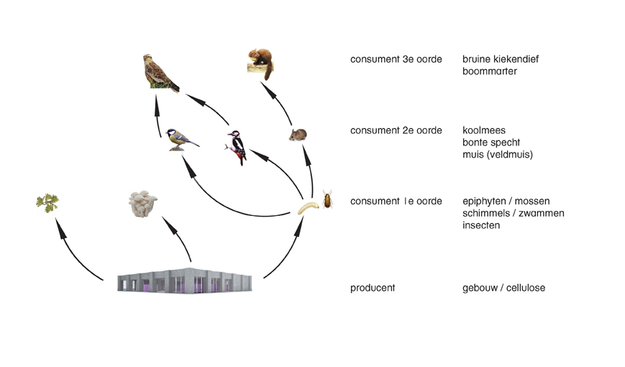Edible Architecture is an ongoing research project investigating mycelium as a construction material.
Edible Architecture radicalizes the relation between architecture and nature, offering an extreme example of sustainable design.
a. It focuses on the development of building materials made of bio mass (from forest and park management or water plants), that are suitable for buildings while at the same time providing a breeding ground for insects, fungi, and other animals and plants. The project explores the material itself as well as the low-tech method of production.
b. Edible Architecture demands a different approach from the usual construction and maintenance of buildings. Therefore we simultaneously investigate the possibilities in collaborating with social parties. The maintenance of the buildings lends itself for participation. The cycle of organic decay and manual renewal reflects on the increasingly hybrid relation between the Natural and the Artificial. The buildings can for example be introduced into nature education.
Mycelium fits the premises of Edible Architecture like a glove. That’s what makes it so interesting to investigate its potential.
Phil Ross, father of the term Mycotecture, developed a mycelium brick to make parabolic spaces. Terreform is currently working on Mycelia Amalgamation Methods for Urban Growth, experimenting with recycled aluminium to reinforce mycelium, but only on a small scale. It should be possible to develop smart and strong materials to further the possibilities of Mycotecture.
We want to use the Mycelium Research Project to develop Reinforced Mycelium.
Reinforced mycelium is a composite material in which mycelium’s relatively low tensile strength is counteracted by the inclusion of a reinforcement, thus having higher tensile strength, to enable stronger constructions.
The focus of our research is on creating a dense and pressure-strong mycelium as well as the binding with the reinforcing materials.
We would like to develop and perfect two techniques:
• We aim to create a dense and pressure-strong mycelium, that can be cast into any shape like plaster or cement.
• We aim to reinforcing mycelium. We will investigate different materials and shapes that can form a connection with the mycelium. We will use mats, baskets and rods of bamboo, willow rods, recycled aluminium or other materials that will arise from our trial and error method. The focus will be on two questions: how will the reinforcement material bind the mycelium, and how long will the tensile forces hold.
Simultaneously we will continue approaching potential clients for a pilot project. We like to cooperate with relevant social parties, exploring possible applications and location opportunities. This assumes a principal or administer who acknowledges the meaning of this unusual form of construction and management. The research is intended to explore the possibilities together with the client step by step. Here practical motives, and particularly motives concerning content play a part. How can Edible Architecture or Mycotecture, contribute to new forms of nature education and nature experience? Will it lend itself for a pavilion that demonstrates the hybrid relation between the Natural and the Artificial? How can the unique, organic building maintenance be used for new types of participative education?
We would like to share and enhance our knowledge to develop a strong and smart material, with which we want to realize a pilot project of reinforced mycelium.
Our team consists of Erik Blits, Jesse Blits and Daniel Schwartz.

